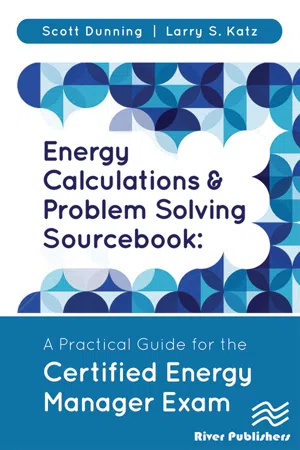
Energy Calculations and Problem Solving Sourcebook
A Practical Guide for the Certified Energy Manager Exam
- 226 pages
- English
- ePUB (mobile friendly)
- Available on iOS & Android
Energy Calculations and Problem Solving Sourcebook
A Practical Guide for the Certified Energy Manager Exam
About this book
Based on the Body of Knowledge, this book is designed to serve as a practical guide for energy professionals preparing to take AEE's Certified Energy Manager® (CEM®) examination. The reference presents an overview of the specific areas of expertise referenced in the current Body of Knowledge in a guided preparatory format, including detailed, specifically targeted reference materials. The full scope of energy calculations and problem solving strategies which must be mastered are presented, covering relevant codes and standards, energy accounting and economics, electrical, lighting and HVAC systems, motors and drives, industrial systems, building envelope, building automation and control systems, renewable energy, boiler and steam systems, thermal storage, maintenance, commissioning, alternative financing, and much more. Green Building, LEED and Energy Star programs are also addressed. The appendix provides a broad range of useful reference tables, as well as mathematical formulas specific to each specific area of energy management addressed. While aimed at those taking the ANSI-certified CEM exam, this text is also an excellent reference to be used throughout an energy manager's professional career.
Frequently asked questions
- Essential is ideal for learners and professionals who enjoy exploring a wide range of subjects. Access the Essential Library with 800,000+ trusted titles and best-sellers across business, personal growth, and the humanities. Includes unlimited reading time and Standard Read Aloud voice.
- Complete: Perfect for advanced learners and researchers needing full, unrestricted access. Unlock 1.4M+ books across hundreds of subjects, including academic and specialized titles. The Complete Plan also includes advanced features like Premium Read Aloud and Research Assistant.
Please note we cannot support devices running on iOS 13 and Android 7 or earlier. Learn more about using the app.
Information
Chapter 1
Codes and Standards
INTRODUCTION
Codes and Standards Subject Topics
ASHRAE/IESNA Standard 90.1-2012ISO 50001IEC and IEEC CodesASHRAE Standard 90.2ASHRAE Standard 62.1-2010Model Energy CodeASHRAE Standard 135-2008
ASHRAE
1. ANSI/ASHRAE/IES Standard 90.1 - 2012
ASHRAE 90.1 covers:
ASHRAE 90.1 does not cover:
ASHRAE 90.1 Energy Elements Covered:
ASHRAE 90.1 Industrial Processes Energy Elements Covered (added in 2013):
Table of contents
- Cover
- Half Title
- Title Page
- Copyright Page
- Table of Contents
- Chapter 1 Codes and Standards
- Chapter 2 Energy Accounting and Economics
- Chapter 3 Energy Audits and Instrumentation
- Chapter 4 Electrical Systems
- Chapter 5 Heating, Ventilation, and Air Conditioning (HVAC Systems
- Chapter 6 Motors and Drives
- Chapter 7 Industrial Systems
- Chapter 8 Building Envelope
- Chapter 9 CHP Systems and Renewable Energy
- Chapter 10 Fuel Supply and Pricing
- Chapter 11 Building Automation and Control Systems
- Chapter 12 High Performance Buildings
- Chapter 13 Thermal Energy Storage Systems
- Chapter 14 Lighting Systems
- Chapter 15 Boiler and Steam Systems
- Chapter 16 Maintenance and Commissioning
- Chapter 17 Energy Savings Performance Contracting and Measurement and Verification
- Appendix Energy Unit Conversions
- Index